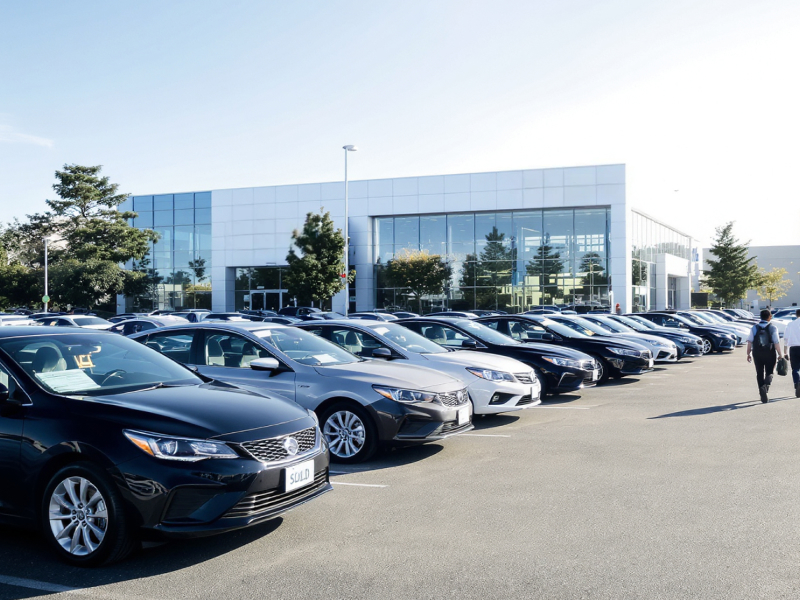The used-car leasing revolution is already underway, and digital-first players are seizing the moment. As startups scale rapidly and redefine customer expectations, traditional leasing firms risk falling dangerously behind.
The used-car leasing boom isn't on the horizon; it's happening now. What was once considered a secondary strategy has rapidly evolved into a primary revenue driver, fundamentally reshaping how consumers and businesses access vehicles.
Digital-first firms and startups are gaining momentum by moving faster, pricing smarter, and delivering better customer experiences. They've recognised that used-car leasing represents more than just an alternative offering; it's a strategic opportunity to capture market share from incumbents who remain anchored to outdated processes and systems.
Traditional leasing firms risk watching from the sidelines unless they accelerate transformation. The window for gradual adaptation is closing as agile competitors continue to redefine customer expectations and capture significant market share.
This article explores how and why agile competitors are winning in the used-car leasing space and what traditional firms must urgently learn to remain competitive.
TL;DR
- Used-car leasing has shifted from niche to necessity, driven by consumer demand for affordability, flexibility, and the rapid adoption of EVs.
- Digital-first startups are capturing market share with seamless platforms, fast onboarding, and subscription-style leasing models that appeal to modern users.
- Traditional leasing firms are losing ground due to outdated systems, fragmented customer journeys, and internal resistance to innovation.
- Startups are achieving measurable results: some have grown fleets by 300% in under 18 months, while others reduce lease processing times to under 10 minutes.
- Poor customer experience is costly: 30% of leasing applications are abandoned, and NPS scores lag 20–30 points behind digital-native competitors.
- To remain competitive, legacy firms must urgently modernise technology, simplify operations, embrace agile development, and transform company culture.
- The window for slow adaptation is closing. Only those willing to act decisively and digitally will thrive in the new leasing landscape.
The Market Is Moving Fast
Used-car leasing is no longer a secondary strategy. For many consumers and businesses, it's become a first choice, driven by compelling economic and practical advantages that align with modern mobility preferences.
Demand is being driven by affordability concerns, flexibility requirements, and widespread EV adoption. Economic pressures have made used-vehicle leasing an attractive alternative to new car purchases, whilst the rapid evolution of electric vehicle technology has created a preference for shorter-term commitments. Meanwhile, legacy players hesitate, often tied down by outdated systems and cautious internal cultures that resist rapid market adaptation.
The numbers tell a compelling story. Used-vehicle fleet size rose nearly 5% year-on-year across Europe, led by leasing growth that outpaced traditional fleet expansion. EV lease penetration hit 45% in recent quarters, driven by affordability considerations and tax incentives that make leasing more attractive than outright purchase. Over 30% of younger customers say they prefer leasing used vehicles over buying outright, reflecting a fundamental shift in ownership preferences.
"The market's moved on. Customers expect digital journeys, flexible terms, and vehicles that match their budget. Used-car leasing ticks all the boxes," explains the Mobility Innovation Lead at a European Leasing Group. This sentiment reflects the broader industry recognition that consumer expectations have evolved faster than many traditional providers can adapt.
The flexibility advantage extends beyond simple cost considerations. Used-car leasing allows customers to access newer technology and features without long-term commitments, particularly appealing for electric vehicles where technology continues to evolve rapidly. This creates a compelling value proposition that startups have been quick to exploit whilst traditional firms struggle to restructure their offerings.
Digital-First Entrants Are Capturing the Gap
Startups like Lizy, Finn, and Cluno have redefined how leasing can look: Fast onboarding, subscription-style UX, and instant quotes that eliminate traditional friction points. These firms view used vehicles as revenue-generating assets, not residual-risk burdens that require careful management.
By leveraging data analytics, automation, and low operational overheads, they offer smoother, cheaper, and faster services that consistently outperform traditional competitors. Their approach focuses on customer experience optimisation rather than asset management, creating differentiated value propositions that resonate with modern consumers.
The results speak for themselves. One digital-native lessor grew its fleet by 300% in under 18 months, demonstrating the scalability advantages of purpose-built platforms. Another firm reduced acquisition-to-contract time to under 10 minutes through full API integration, showcasing the efficiency gains possible with modern technology stacks.
"We've built our platform around the customer, not the car. That's why we're winning," states the CEO of a digital car leasing startup, highlighting the fundamental philosophical difference between new entrants and traditional players.
These companies have embraced subscription economy principles, offering transparent pricing, flexible terms, and seamless digital experiences that mirror successful models from other industries. Their technology stacks are built for scalability and integration, enabling rapid feature deployment and continuous improvement based on customer feedback.
The competitive advantage extends beyond technology to include business model innovation. Digital-first entrants often offer all-inclusive packages that bundle insurance, maintenance, and roadside assistance, simplifying the customer experience whilst creating additional revenue streams. This holistic approach contrasts sharply with traditional leasing models that often require customers to manage multiple vendor relationships.
Legacy Firms Are Paralysed by Complexity
Multiple systems, manual processes, and long internal approval cycles make it nearly impossible for traditional firms to pivot quickly to capture emerging market opportunities. Many still treat used leasing as a bolt-on offer rather than a strategic focus, limiting their ability to develop competitive advantages.
Some spend 70% or more of their tech budgets on maintaining outdated infrastructure, leaving minimal resources for innovation or customer experience improvements. This creates a vicious cycle where legacy systems constrain growth whilst consuming resources that could drive competitive differentiation.
The operational challenges are significant. Customer-facing representatives in legacy leasing firms often work across 7 or more systems to complete a single transaction, creating friction that impacts both employee productivity and customer satisfaction. Innovation timelines stretch to 12–24 months, compared to weeks for startups, making it difficult to respond to market changes or customer demands.
"Legacy systems aren't just slowing us down, they're stopping us entirely," admits the Head of Product at a National Leasing Firm, reflecting the frustration many traditional players experience when attempting to modernise their operations.
Internal approval processes compound these challenges. Traditional firms often require multiple stakeholder approvals for technology changes, pricing adjustments, or new product launches. These governance structures, designed for stability and risk management, become barriers to innovation when market conditions demand rapid adaptation.
The cultural challenges are equally significant. Many legacy firms have developed risk-averse cultures that prioritise stability over innovation, making it difficult to embrace the experimental approaches that drive startup success. This cultural inertia often proves more challenging to overcome than technical limitations.
Missed Customer Expectations Create Openings
Today's leasing customer expects a digital, seamless, end-to-end experience that mirrors the convenience and transparency they experience in other industries. These expectations have been shaped by successful digital experiences in banking, retail, and entertainment, creating new standards for automotive services.
Startups are consistently delivering superior user experiences with transparent pricing, fast approvals, and flexible terms that adapt to customer needs. Their customer journeys are designed for conversion optimisation, removing friction points that traditional processes create. Legacy players risk high abandonment rates and low retention due to friction-heavy journeys that frustrate customers and create competitive disadvantages.
The impact on customer behaviour is measurable. Over 30% of customers abandon lease applications due to lack of clarity or delays, representing significant lost revenue for traditional providers. NPS scores for digital-first lessors are 20–30 points higher than traditional counterparts, indicating substantial satisfaction gaps that create competitive vulnerabilities.
"If your customer journey takes three calls and two emails, you've already lost them," warns the Head of Customer Experience at a Mobility Startup, highlighting the importance of streamlined processes in customer acquisition and retention.
The expectation gap extends beyond simple convenience to include transparency and control. Modern customers expect real-time status updates, transparent pricing structures, and the ability to modify their agreements through self-service portals. Traditional leasing firms often struggle to provide these capabilities due to system limitations and process constraints.
Digital expectations also include personalisation and intelligent recommendations. Customers expect platforms to understand their preferences, suggest relevant options, and provide tailored pricing based on their specific circumstances. Achieving this level of personalisation requires data integration and analytical capabilities that many traditional firms lack.
Innovation as a Competitive Weapon
Agile competitors are using artificial intelligence, real-time pricing, and dynamic risk models to consistently outperform incumbents across key performance metrics. These technologies enable more accurate pricing, better risk assessment, and improved customer targeting that drive superior business outcomes.
They run lean pilots, iterate quickly, and expand only what works, compared to big-bang launches that traditional firms often favour. This approach enables rapid learning and adaptation, allowing successful innovations to scale whilst minimising the impact of unsuccessful experiments.
The results demonstrate clear competitive advantages. Predictive pricing models have cut cost errors by 8% and improved lease profitability through more accurate risk assessment and market-responsive pricing. Agile firms bring new offerings to market in as little as 6–8 weeks, enabling them to respond quickly to customer feedback and market opportunities.
"Innovation isn't a buzzword; it's our moat," declares the Founder of a Fast-Growth Mobility Platform, emphasising the strategic importance of continuous innovation in maintaining competitive advantage.
Technology innovation extends beyond customer-facing applications to include operational improvements. AI-powered vehicle inspection systems can assess used car condition more accurately and consistently than manual processes, whilst automated pricing algorithms can adjust rates based on market conditions and inventory levels in real-time.
The agile development approach also enables continuous improvement based on customer feedback and market data. Rather than waiting for major system upgrades, these firms can implement incremental improvements that collectively create significant competitive advantages over time.
Seizing the Competitive Advantage
Legacy leasing firms must treat the current moment as a tipping point rather than a temporary market fluctuation. The competitive dynamics have shifted permanently, and the cost of inaction grows with each passing quarter as agile competitors continue to capture market share and customer mindshare.
The competition isn't waiting for traditional firms to catch up and market share lost to faster competitors proves increasingly difficult to recover. First-mover advantages in customer acquisition, brand recognition, and operational efficiency create compounding benefits that become harder to overcome as markets mature.
Successful transformation requires a fundamental shift in approach. Start by identifying areas of internal friction that impact customer experience and operational efficiency. Launch pilot programmes that enable rapid testing and learning without requiring comprehensive system overhauls. Modernise technology stacks where customer value is clearest and competitive differentiation is most achievable.
The path forward demands both strategic clarity and operational agility. Traditional firms must embrace the experimental mindset that drives startup success whilst leveraging their existing advantages in customer relationships, regulatory compliance, and operational scale. The firms that successfully balance these requirements will emerge as winners in the evolving used-car leasing market.
Success requires immediate action across multiple fronts: technology modernisation, process simplification, cultural transformation, and customer experience optimisation. The window for gradual adaptation is closing, but opportunities remain for firms willing to embrace the fundamental changes required to compete effectively in the new market reality.
Frequently Asked Questions
What makes digital-first leasing companies more competitive than traditional firms?
Digital-first companies leverage modern technology stacks, streamlined processes, and customer-centric design to offer faster, cheaper, and more convenient services. They're built for agility and can adapt quickly to market changes, whilst traditional firms often struggle with legacy systems and complex approval processes.
How significant is the growth in used-car leasing?
The used-car leasing market is experiencing substantial growth, with used-vehicle fleet sizes rising nearly 5% year-on-year across Europe. EV lease penetration has reached 45%, and over 30% of younger customers now prefer leasing used vehicles over purchasing outright.
What are the main challenges facing legacy leasing firms?
Legacy firms face technical debt from outdated systems, complex internal processes, slow innovation cycles, and cultural resistance to change. They often spend 70% of their tech budgets maintaining existing infrastructure, leaving limited resources for innovation and customer experience improvements.
Can traditional leasing firms compete with digital startups?
Yes, but it requires fundamental transformation. Traditional firms must modernise their technology stacks, streamline customer journeys, embrace agile development practices, and shift from product-centric to customer-centric approaches. Success depends on willingness to invest in change and accept short-term disruption for long-term competitiveness.
What role does customer experience play in competitive advantage?
Customer experience has become the primary differentiator in used-car leasing. Digital-first firms consistently achieve NPS scores 20-30 points higher than traditional competitors by offering transparent pricing, fast approvals, and seamless digital journeys. Poor customer experience leads to high abandonment rates and lost market share.
Taking Action in a Transforming Market
The used-car leasing market transformation represents both a critical challenge and a significant opportunity for traditional firms. The competitive landscape has shifted permanently, with agile competitors continuing to raise customer expectations whilst capturing increasing market share.
Success requires recognising that incremental improvements won't suffice, fundamental transformation is necessary to compete effectively. The firms that embrace this reality and take decisive action will position themselves for long-term success in the evolving mobility ecosystem.
The time for hesitation has passed. Market dynamics favour firms that can move quickly, think digitally, and prioritise customer experience above operational convenience. Traditional leasing firms have valuable assets, customer relationships, operational scale, and regulatory expertise. But these advantages only matter if they can be leveraged through modern, customer-centric approaches.
Start the transformation today by identifying quick wins that improve customer experience, investing in technology that enables agility, and developing the organisational capabilities required for continuous innovation. The market won't wait, but opportunities remain for firms ready to embrace the future of used-car leasing.
Explore Our Latest Insights
Discover trends and innovations in the automotive sector.







